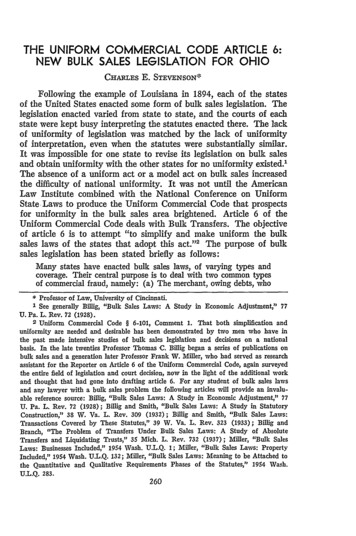
Transcription
THE UNIFORM COMMERCIAL CODE ARTICLE 6:NEW BULK SALES LEGISLATION FOR OHIOCHARLES E. STEVENSON Following the example of Louisiana in 1894, each of the statesof the United States enacted some form of bulk sales legislation. Thelegislation enacted varied from state to state, and the courts of eachstate were kept busy interpreting the statutes enacted there. The lackof uniformity of legislation was matched by the lack of uniformityof interpretation, even when the statutes were substantially similar.It was impossible for one state to revise its legislation on bulk salesand obtain uniformity with the other states for no uniformity existed.'The absence of a uniform act or a model act on bulk sales increasedthe difficulty of national uniformity. It was not until the AmericanLaw Institute combined with the National Conference on UniformStateLaws to produce the Uniform Commercial Code that prospectsfor uniformity in the bulk sales area brightened. Article 6 of theUniform Commercial Code deals with Bulk Transfers. The objectiveof article 6 is to attempt "to simplify and make uniform the bulksales laws of the states that adopt this act."2 The purpose of bulksales legislation has been stated briefly as follows:Many states have enacted bulk sales laws, of varying types andcoverage. Their central purpose is to deal with two common typesof commercial fraud, namely: (a) The merchant, owing debts, whoProfessor of Law, University of Cincinnati.1 See generally Billig, "Bulk Sales Laws: A Study in Economic Adjustment," 77U. Pa. L. Rev. 72 (1928).2 Uniform Commercial Code § 6-101, Comment 1. That both simplification anduniformity are needed and desirable has been demonstrated by two men who have inthe past made intensive studies of bulk sales legislation and decisions on a nationalbasis. In the late twenties Professor Thomas 'C.Billig began a series of publications onbulk sales and a generation later Professor Frank W. Miller, who had served as researchassistant for the Reporter on Article 6 of the Uniform Commercial Code, again surveyedthe entire field of legislation and court decision, now in the light of the additional workand thought that had gone into drafting article 6. For any student of bulk sales lawsand any lawyer with a bulk sales problem the following articles will provide an invaluable reference source: Billig, "Bulk Sales Laws: A Study in Economic Adjustment," 77U. Pa. L. Rev. 72 (1928); Billig and Smith, "Bulk Sales Laws: A Study in StatutoryConstruction," 38 W. Va. L. Rev. 309 (1932); Billig and Smith, "Bulk Sales Laws:Transactions Covered by These Statutes," 39 W. Va. L. Rev. 323 (1933); Bilig andBranch, "The Problem of Transfers Under Bulk Sales Laws: A Study of AbsoluteTransfers and Liquidating Trusts," 35 Mich. L. Rev. 732 (1937); Miller, "Bulk SalesLaws: Businesses Included," 1954 Wash. U.L.Q. 1; Miller, "Bulk Sales Laws: PropertyIncluded," 1954 Wash. U.L.Q. 132; Miller, "Bulk Sales Laws: Meaning to be Attached tothe Quantitative and Qualitative Requirements Phases of the Statutes," 1954 Wash.U.L.Q. 283.
NEW BULK SALES LEGISLATIONsells out his stock in trade to a friend for less than it is worth, payshis creditors less than he owes them, and hopes to come back intothe business through the back door some time in the future. (b) Themerchant, owing debts, who sells out his stock in trade to any onefor any price, pocketsthe proceeds, and disappears leaving his3creditors unpaid.The objective of this article is to study some of the areas in whichchange in the bulk sales law of Ohio has been made or may be anticipated by enactment of Article 6 of the Uniform Commercial Code.The present Ohio law on bulk sales is found in Revised Codesections 1313.53 to 1313.55. These sections or their predecessors havebeen in effect in Ohio now for about a half century.4 In spite of asubstantial number of interpretations by the courts, the act has beensuccessful in Ohio. Certainly no one has seriously suggested its repeal. The passage of time, however, has indicated some areas inwhich changes are desirable both to provide more national uniformityand to adjust to the needs of a changing commercial environment.The Uniform Commercial Code Article on Bulk Transfers iscomprised of eleven sections, sections 6-101 through 6-111. Thefirst of these sections merely states the short title to the act and wasnot enacted in Ohio. Section 6-106 is an optional section providingfor the application of the proceeds of a bulk sale to the payment ofdebts of the transferor. It was not enacted in Ohio. Aside from thesetwo sections the Article on Bulk Transfers was enacted in its entiretyin Ohio, with one addition which will be discussed later in thisarticle.5 The new Ohio law on bulk transfers will be Revised Codesections 1306.01 through 1306.09, effective July 1, 1962. For convenience in this article the present statutory provisions in Ohio onbulk sales will be referred to as they appear in the Revised Code andthe provisions of article 6 will be referred to as they appear in theUniform Commercial Code.BusiNEsSES AND PROPERTY COVERED BY THE ACTSection 6-102 of the Uniform Commercial Code sets out thetypes of transactions, the types of property, and the types of enterprises covered by the article. It reads as follows:(1) A "bulk transfer" is any transfer in bulk and not made in theordinary course of the transferor's business of a major part of the3 UCC § 6-101, Comment 2.4 See Lattin, 35 Ohio Jur. 729, for a short history of bulk sales legislation in Ohio.See also Folkerth, "Sales in Bulk," 15 Ohio St. L.J. 43 (1954).5 The additional provision requires a certificate from the county treasurer showingall taxes are paid.
OHIO STATE LAW JOURNAL[Vol. 23materials, supplies, merchandise or other inventory (Section 9-109)of an enterprise subject to this Article.(2) A transfer of a substantial part of the equipment (Section9-109) of such an enterprise is a bulk transfer if it is made in connection with a bulk transfer of inventory, but not otherwise.(3) The enterprises subject to this Article are all those whoseprincipal business is the sale of merchandise from stock, includingthose who manufacture what they sell.(4) Except as limited by the following section all bulk transfersof goods located within this state are subject to this Article.We must note particularly several provisions in this section. Inorder for the bulk transfers article to apply to a sale of goods the salemust be "in bulk." Also, the sale must not be "in the ordinary courseof the transferor's business." The sale must be of a "major part" ofthe "materials, supplies or other inventory" of the business. Sales of"equipment" unaccompanied by sales of inventory are not coveredby the article. Some sales are excepted from operation of the article.Some of the provisions in this section are new to Ohio." Few if anyare new to bulk sales legislation on a national basis. Let us look to themeaning of these terms and see how, if at all, they change the law ofOhio."IN BULK"Since the beginning of bulk sales legislation in 1894, the term"sale in bulk" has been used in by far the majority of the statutesenacted on the subject. A few statutes have omitted the phrasewithout apparent change in the results in that state. 7 None of thestatutes has adequately defined the term and most of the statuteshave not attempted to define it at all.8 Much as been written aboutthe meaning of the term. Some authors have felt that it is a qualitativeterm, referring to the type of the transaction. 9 Others have felt that6 The provision of the Ohio statutes comparable to the section of the Uniform Commercial Code listed above appears in the first part of Ohio Rev. Code § 1313.54:The sale, transfer, or assignment, in bulk, of any part or the whole of a stockof merchandise, or merchandise and the fixtures pertaining to the conductingof the business, or the sale, transfer, or assignment in bulk of the fixtures pertaining to the conducting of said business, otherwise than in the ordinarycourse of trade and in the regular and usual prosecution of the business of theseller, transferor, or assignor is void as against creditors of the seller, .7 Billig and Branch, "The Problem of Transfers Under Bulk Sales Laws: A Studyof Absolute Transfers and Liquidating Trusts," 35 Mich. L. Rev. 732, 739 (1937).8 For example, no definition appears in Ohio Rev. Code §§ 1313.53-1313.55.9 Miller, "Bulk Sales Laws: Meaning to be Attached to the Quantitative and Qualitative Requirements Phases of the Statutes," 1954 Wash. U.L.Q. 283, 284. The problemthen arises, as Professor Miller points out, how does it differ from the term "ordinarycourse of business?"
19621NEW BULK SALES LEGISLATIONit is a quantitative term, dealing with the size of the sale.10 In somerespects the word seems to have a sort of chameleon nature, varyingfrom case to case depending on the facts of the case. In the pastneither the cases nor the writings seem to have worried about themeaning of the term "in bulk" as used in the Ohio code. It is not likelythat its meaning will be debated extensively in the future. Littlechange in its meaning was intended by the enactment of the UniformCommercial Code. It has been suggested that in the future under theUniform Commercial Code the term "in bulk" may well be "utilizedto include a series of transactions which, when viewed collectively,constitute a major part of the included property . . . ."I Inasmuchas prior Ohio bulk sales legislation covered a sale in bulk of "any"part of a stock of merchandise, such an interpretation was there unnecessary. In a proper situation, the suggested interpretation maywell be used."ORDINARYCOURSE OF THE TRANSFEROR'S BUSINESS"The Uniform Commercial Code covers transfers in bulk "andnot in the ordinary course of the transferor's business." When thisis compared with the language of Revised Code section 1313.54,"otherwise than in the ordinary course of trade and in the regularand usual prosecution of the business of the seller,"" the similarityis apparent. In spite of the differences which appear in the languageused, it seems clear that both enactments are speaking of the usualconduct of the business of this particular transferor and not someobjective standard based on the usage of trade in this type of business, even though at times this may be considered. This interpretationis in accord with the great weight of authority in the United Statesinterpreting comparable language."In spite of the similarity of the language of the Uniform Commercial Code to the prior statute law of Ohio, a subtle change inmeaning of the phrase "in the ordinary course of trade and in theregular and usual prosecution of the business" may well have takenplace. In the past in Ohio this phrase may well have had quantitativeovertones that are no longer present. The present bulk sales legislation applies to sales of "any part" of the merchandise.' 4 Thus, if10 Billig and Branch, supra note 7. The problem then is, how does it differ fromthe other quantitative requirements in the acts?11 Miller, supra note 9, at 323. This partciular problem is closely involved withthe term "major part," discussed later.12 Ohio Rev. Code § 1313.54, supra note 6.13 Miller, supra note 9, at 304.14 Ohio Rev. Code § 1313.54, supra note 6.
OHIO STATE LAW JOURNAL[Vol. 23the usual conduct of the business involved sales of relatively smallquantities of merchandise, a sale of a larger quantity might well beheld to be not in the ordinary course of trade and in the regular andusual prosecution of the business. With the addition in the UniformCommercial Code of the requirement that the sale be of a "majorpart" of the inventory before the statute applies, the inference to bedrawn from the phrase "in the ordinary course of the transferor'sbusiness" seems to have changed. Now the wording seems to bedirected more to the nature of the transfer than to the quantity ofgoods sold. The test most likely to be applied to determine if aparticular transfer is in the ordinary course of trade under the Uniform Commercial Code will be whether the transferor has in thisinstance dealt with a customer of the class with whom he ordinarilydeals, or perhaps, if it is a new class of customers for the transferor,15whether sales to customers of this class are usual within the trade.If so, then the sale likely will be held to be in the ordinary course ofthe transferor's business. Even if a change in meaning of this termhas been effected, it is not likely to produce much litigation."C'MAJOR PAT"A feature new to the law of Ohio is the requirement of the Uniform Commercial Code that the transfer be of a "major part" of theinventory of the transferor before the transaction will be governedby the requirements of the article on bulk transfers. This new provision presents several interesting questions. What does it mean?Why was the law changed? How does the change affect the operationof the prior bulk sales legislation?Although this provision for a "major part" is new to the law ofOhio, it or somewhat similar provisions have been enacted in otherstates for a considerable time. The statutes of five states have setout the quantitative requirement that the transfer be of a "majorpart" of the goods.'" Another group of states have a requirementthat a "large part" of the goods of the transferor must be involved."Still other states provided that the bulk sales legislation was to applyinvolved inter'r Sternberg v. Rubinstein, 305 N.Y. 235, 112 N.E.2d 210 (1953)pretation of a statute similar to the present Ohio statute. The case involved a sale ofoff season stock at wholesale by a retail merchant. In holding that the sale was in theordinary course of business the court seemingly gave considerable weight to the practiceof businesses of this type. Enactment of the "major part" provision of the Uniform Commercial Code will substantially reduce the probability that cases of this type will arise.18 -Conn. Gen. State. § 6705 (1949) ; Ill. Ann. Stat. c. 121y, § 78 (Supp. 1960) ; Mo.Ann. Stat. § 427.020 (1949); R.I. Gen. Laws § 6-16-2 (1956); S.C. Code § 11-201 (1952).17 E.g., N.C. Gen. Stat. § 39-23 (1950).
NEW BULK SALES LEGISLATIONonly if all or substantially all of the goods were sold.', The bulk salesprovision in Ohio---"any part or the whole"-is typical of the law ofthe balance of the states.' 9 The choice of the term "major part" inthe Uniform Commercial Code may well have been intended as acompromise between the policies of those states such as Ohio whichhad provided a maximum security to creditors and those where protection was provided only in cases of transfers of all or substantiallyall of the inventory of the seller. In addition, if a seller in fact plansto defraud his creditors by selling out his stock in trade and pocketingthe proceeds, he probably will desire to sell at least a major part ofthe stock. In spite of this we still have problems. We need to know whatis meant by the term "major part," what opportunities are open to a"bad man" attempting to defraud his creditors by a bulk transfer,and what dangers are faced by a "good man" desiring to purchase asupply of goods if he does not follow the formalities of the bulktransfer legislation.The words "major part" have been construed to mean more thanfifty percent of the property involved.' In addition, there is evidenceindicating that more than one-half was the meaning intended by thedraftsmen of the Uniform Commercial Code.2 ' In spite of this,though, the argument may well be made by any creditor-orientedlawyer that the term "major part" should be interpreted to mean"substantial part" and not more than one-half.22 If more than onehalf were meant, it would be simple enough to say it. All in all,however, it seems likely that the term "major part" will be interpreted to mean more than fifty percent by value of the inventory.If it is held to mean anything other than the fifty percent division, itwill continue the lack of uniformity among the states that has solong existed.Even if it is assumed that the court will interpret the meaning of18 E.g., Fla. Stat. Ann. § 726.05 (1944).19 Ohio Rev. Code § 1313.54, supra note 6.20 Zenith Radio Distributing Corp. v. Mateer, 311 Ill. App. 263, 35 N.E.2d 815(1941).21 Official comments on the meaning of "major part" are practically non-existent.Uniform Commercial Code comment 4 § 6-102, indicates that the kind of transferscovered in this section are the ones felt to be those that carry the major bulk sales risks,but it does not aid in defining the term "major part." In Miller, "The Effect of theBulk Sales Article on Existing Commercial Practices," 16 Law & Contemp. Prob. 267,269 (1951), referring to "major part," it is stated: "The term means simply more thanone-half of the total stock." In view of Professor Miller's position as research assistantto the Reporter on article 6, this statement may well be conclusive of the intent of thedraftsmen.22 See 30 11.BJ. 298 (1942) for a comment urging this type approach to the interpretation of "major part."
OHIO STATE LAW JOURNAL[Vol. 23"major part" so as to give a maximum of certainty to businessmen,equating it to more than one-half, some touchy problems may stillarise. For example, the businessman may sell all or substantially allof the inventory of some part of his business. Even though the valueof what was sold was less than one-half the value of his entire stock,the question may well be raised whether the fact that the sale involvedmore than one-half of the inventory of this particular item will bringit under the bulk transfers legislation. Then again, the businessmanmay transfer less than one-half of his inventory each time but by aseries of transfers over a period of time, to the same person or todifferent persons, may succeed in selling substantially all his inventory.Will such a series of transfers fall under the bulk transfers legislation? Finally, a businessman desiring to dispose of his inventory maysell on the same day or over a short period of time, to a number ofdifferent persons in a number of unrelated sales so far as' the purchasers are concerned, what will amount .to substantially all his inventory even though each purchaser has bought less than one-half ofit. Will such a series of transfers come under the bulk transferslegislation? We can at least see the result reached in situations of thistype under prior legislation of sister states which contained a "majorpart" clause. In the absence of interpretations under the UniformCommercial Code these decisions from sister states may well be ofconsiderable importance.If the businessman transfers all his inventory covering onephase of his business to a purchaser, and this amounts to less than onehalf of the value of all his inventory, it is probable that the transactionwill not be classed as a bulk transfer for purposes of the UniformCommercial Code.2 3 A similar situation, with like result, may arisewhen a business with a number of outlets disposes of one of theseoutlets and all the stock therein. Again, such a transfer should notbe held to be a transfer of a major part of the inventory merely because all of a part was sold.2 4 The procedure best adapted to thedetermination of one-half under the Uniform Commercial Codeseems to be to take as the numerator of the fraction the value of thegoods transferred and as the denominator the total value of thegoods of the particular business at the time of the transfer.If the businessman sells to one man his inventory in a series oftransactions over a fairly short period of time in such quantities that23 Blanchard Co. v. Ward, 124 Wash. 204, 213 Pac. 929 (1923) (sale of sheet musicby a piano store and music house, not a bulk sale).24 Keller v. Fowler Bros. & Cox, 148 Tenn. 571, 256 S.W. 879 (1923) (sale of partof a business held not in the ordinary course of trade, thus violating a bulk sales lawcovering a sale in bulk of "any part").
1962]NEW BULK SALES LEGISLATIONno one sale violates the bulk transfers article, but the quantity of theentire group of transfers is more than one-half of the inventory, itseems fairly clear that the entire group of transfers should be groupedand held as one transaction, ineffective as to creditors of the transferor. 25 Evasion of the act would be too simple and easy if this resultdid not obtain. Even though there is a policy of protecting bona fidepurchasers, it is hard to find a policy of protecting the purchaser insuch a situation as this. In connection with this situation, the suggestion has been made that the term "in bulk" could be used to covera series of transactions.26 Further, if the sales were to differentpersons acting in concert, or who were aware that the other saleswere taking place or had taken place, the same result should follow.There is no policy of aiding one who attempts to make a profit afterhe has notice that another may well be attempting to defraud hiscreditors.If the businessman transfers his inventory to various parties in aseries of transactions over a fairly short period of time, so that noone of the transfers violates the major part provision of the BulkTransfers Article, but the entire group of transfers does violate it,a choice again must be made between protection of creditors and protection of bona fide purchasers. In cases such as this it seems indeedharsh to hold that the group of transfers shall be considered as oneto determine if there has been a transfer of a major part of the inventory so as to bring the group of transactions under article 6, ifnone of the purchasers had knowledge or notice of the other transfers.27 In cases such as this, once the "major part" policy has beenadopted by the state, the need for protection of purchasers seems tooutweigh the need for protection of creditors. The risk to creditorsin cases of this type seems to be inherent in the establishment of adefinite quantitative standard. The result suggested would followonly if the particular purchaser involved had bought less than onehalf the inventory in the hands of the businessman at the time of hispurchase. Even though this may seem self evident, it does raise theproblem of the time when the quantity or value of inventory is to bemeasured. If what is purchased by a bona fide purchaser, withoutnotice of other transactions, amounts to less than one-half of what25 Sabin v. Horenstein, 260 Fed. 754 (9th Cir. 1919); Thorndike & Hix LobsterCo. v. Hall, 223 App. Div. 576, 229 N.Y. Supp. 225 (1928) ; Slaughter v. Cooper Corporation No. 2, 20 Tenn. App. 241, 97 SV.2d 648 (1936).26 See text at note 11 infra.27 Hughes-Curry Packing Company v. Sprague, 200 Ind. 540, 165 N.E. 318 (1929).See also comment, 3 Ind. L.J. 565 (1928), approving a contra result at the appellatecourt level.
OHIO STATE LAW JOURNAL[Vol. 23the transferor owns at the time of the sale, the purchaser should notbe subject to the bulk transfers provisions. On the other hand, thepurchaser may at times purchase what amounts to less than one-halfof the inventory formerly owned but now depleted due to prior sales.At this point the purchaser may desire to define the total inventory ofthe transferor in terms of the sum of both what had been sold earlierand what remained, so that it will appear that the purchaser hasbought less than one-half the inventory. A purchaser who has reachedthis point has indeed a narrow line to tread between Scylla andCharybdis. On the one hand, he desires to "tack on" the prior salesof inventory for the purpose of showing that his purchase was lessthan one-half; on the other, he wants to avoid "tacking on" the priorsales to his own purchase if it will end up showing that the sum of thetwo sales amounted to more than one-half of the entire inventory, andthis result would seem likely.2" A logical solution to situations of thistype seems to be to hold that in the absence of knowledge by thepurchaser of the prior sales there can be no "tacking on" of the priorsales for any purpose and in the event of such knowledge the valueof the prior sales shall be used both for the purpose of determiningtotal inventory and the total amount sold in bulk.The introduction of the new term "major part" into the bulktransfers legislation in Ohio has brought about a major change in thelaw. It may well produce a rash of litigation for a time until thebusinessmen and lawyers in Ohio manage to establish more clearlythe meanings of the term. In spite of the significant changes, it maywell be a better provision than was the old one, and even if it is notas good, the fact we are now on our way toward national uniformityin this field may well make it worth while."INVENTORY," "ENTERPRISE," "EQUIPMENT"Very closely related are the types of businesses covered by bulktransfers legislation and the types of goods subject to the legislation.Often the provisions for both the businesses and the goods appear inthe same clauses. The reference to the goods covered by the legislation on bulk sales in the present Ohio legislation is in terms of a"stock of merchandise or merchandise and the fixtures pertaining to28 See three cases from Illinois on this general problem: Larson v. Judd, 200 Ill.App. 420 (1916) (permitted the second purchaser to increase the quantity of "inventory"by adding to that on hand at the time of his purchase some that had been previouslysold, thus avoiding the bulk sales laws); Main v. Hall, 41 F.2d 715 (7th Cir. 1930) (refused to permit the quantity of inventory to be thus increased); Corrigan v. Miller,338 Ill. App. 212, 86 N.E.2d 853 (1949) (added the prior sale both to the remainingproperty and to the second sale).
NEW BULK SALES LEGISLATIONthe conducting of said business, or. the fixtures pertaining to theconducting of said business . .,,29Only to a minor extent is thislanguage reflected in the Uniform Commercial Code, which speaksin terms of "materials, supplies, merchandise, or other inventory ofan enterprise"m in one part and of "equipment" in another. 3' In thepresent Ohio legislation the principal if not the only indication of theparticular types of businesses subject to the bulk sales legislation isfound in the statement that "the sale, transfer, or assignment, in bulk,of any part or the whole of a stock of merchandise. ."is covered bythe legislation,3 2 and the inference to be drawn therefrom is that unlessthe business is selling merchandise it is not covered by the act. TheUniform Commercial Code states that the enterprises subject to thisarticle are all those whose principal business is the sale of merchandise33from stock, including those who manufacture what they sell."With regard to the types of businesses subject to bulk transferslegislation, it is probable that the Uniform Commercial Code hasmade few changes in the present Ohio law. The courts in Ohio inattempting to determine by a process of inclusion and exclusion whatbusinesses are covered have concluded that they are not covered ifthey are in the business of providing services rather than sellinggoods. Thus hotels3 4 and restaurants 35 are not covered. In the comments to the Uniform Commercial Code it is pointed out that thebusinesses covered "do not include farming nor contracting nor professional services, nor such things as cleaning shops, barber shops,pool halls, hotels, restaurants, and the like whose principal business isthe sale not of merchandise but of services." 3 To the extent thepresent Ohio legislation has been interpreted it seems to be closelyin agreement with the Uniform Commercial Code in regard to thebusinesses covered. However, one change does seem to have beenmade as to the type of business covered. In the past it has been heldthat even though the principal busines of a restaurant was the saleof services, if it maintained a cigar, cigarette, and chewing gumcounter it was engaged in the sale of merchandise and subject to bulksales legislation. 37 Under the test of the Uniform Commercial Code29 Ohio Rev. Code § 1313.54, supra note 6.30 UCC § 6-102(1).31 UCC § 6-102(2).32 Ohio Rev. Code § 1313.54, supra note 6.33 UCC § 6-102(3).34353037Oberlin v. Harokopas, 44 Ohio App. 111, 184 N.E. 257 (1932).Block v. New Era Cafe Inc., 7 Ohio Ops. 507, 23 Ohio L. Abs. 131 (1932).UCC § 6-102, Comment 2.Block v. New Era Cafe Inc., supra note 35.
OHIO STATE LAW JOURNAL[Vol. 23it would appear that the principal business in such a case was not thesale of merchandise from stock, but rather of services, and the business would not be covered. Another change may have been made bythe inclusion of those who manufacture what they sell within theterms of article 6. Under present legislation we have no decisions onthis point, and the cases from other jurisdictions are in conflict.Whether or not this clause represents a change, all can agree that it iswell to have the point settled.Although the changes made by the Uniform Commercial Code inthe types of businesses covered by the bulk transfers article areminor, some substantial changes have been made with regard to thetypes of property subject to the new legislation. Whereas the presentlegislation speaks of merchandise, merchandise and fixtures, or thefixtures of the business, the new legislation has changed both theterminology and the coverage. The term "fixtures" is not used inarticle 6 and in its place we find the term "equipment. ' 38 Equipmentthen is defined as follows:Goods are "equipment" if they are bought for use primarily inbusiness (including farming or a profession) or by a debtor who isa non-profit organization or a governmental subdivision or agencyor if the goods are not includedin the definition of inventory, farm39products or consumer goods.This is closely tied in with the definition of "inventory" in the Code,where it is stated:Goods are inventory if they are held by a person who holds them forsale or lease or to be furnished under contracts of service or if hehas so furnished them, or if they are raw materials, work in processor mater
Uniform Commercial Code deals with Bulk Transfers. The objective of article 6 is to attempt "to simplify and make uniform the bulk sales laws of the states that adopt this act."2 The purpose of bulk sales legislation has been stated briefly as follows: Many states have enacted bulk sales laws, of varying types and .

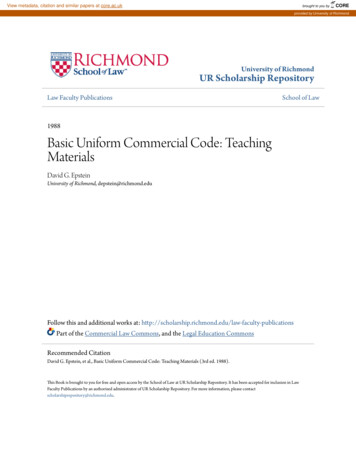
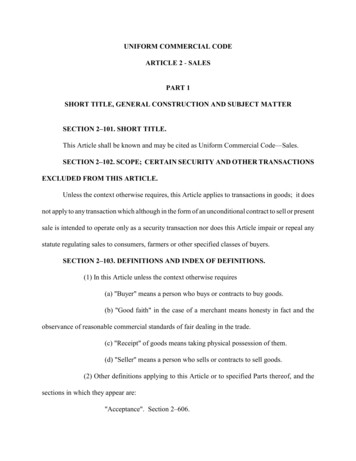
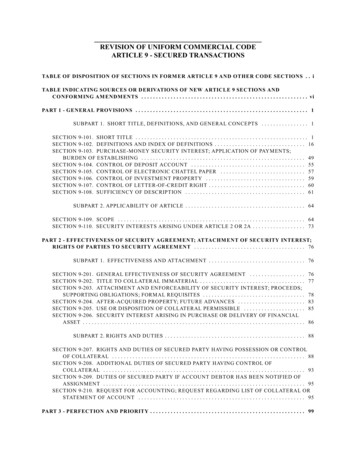
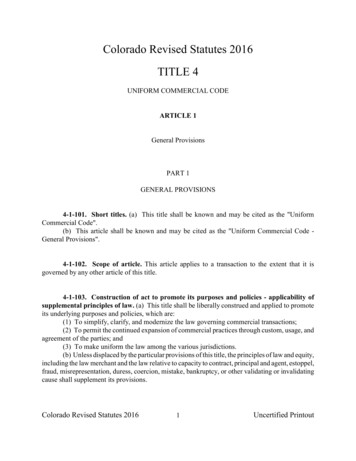
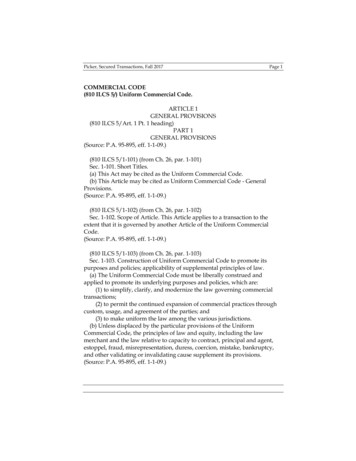
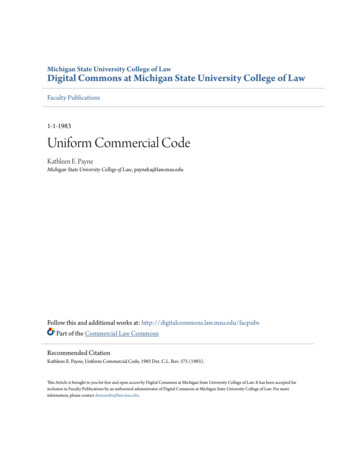
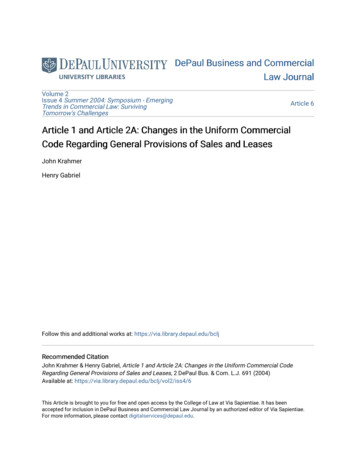

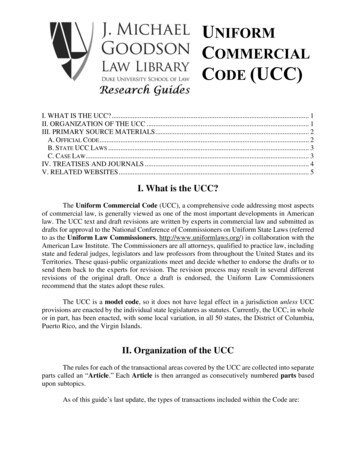

![Solar Code Development v2.5 [Read-Only]](/img/63/solar-20code-20development-20vfinal.jpg)